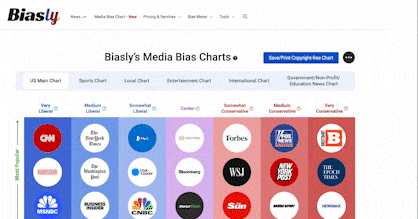 Wall Street Journal Article Rating
Wall Street Journal Article RatingWhat Tax Advisers Say the Midterm Elections Mean for Your Financial Plans
- Bias Rating
- Reliability
N/AN/A
- Policy Leaning
46% Medium Right
- Politician Portrayal
14% Negative
Continue For Free
Create your free account to see the in-depth bias analytics and more.
By creating an account, you agree to our Terms and Privacy Policy, and subscribe to email updates.
Bias Score Analysis
The A.I. bias rating includes policy and politician portrayal leanings based on the author’s tone found in the article using machine learning. Bias scores are on a scale of -100% to 100% with higher negative scores being more liberal and higher positive scores being more conservative, and 0% being neutral.
Sentiments
N/A
- Liberal
- Conservative
| Sentence | Sentiment | Bias |
|---|---|---|
Unlock this feature by upgrading to the Pro plan. | ||
Reliability Score Analysis
Policy Leaning Analysis
Politician Portrayal Analysis
Bias Meter
Extremely
Liberal
Very
Liberal
Moderately
Liberal
Somewhat Liberal
Center
Somewhat Conservative
Moderately
Conservative
Very
Conservative
Extremely
Conservative
-100%
Liberal
100%
Conservative

Contributing sentiments towards policy:
51% : For example, Mr. Keebler said, a married couple in the 24% tax bracket who typically give $15,000 annually to charity would save $3,384 in taxes by lumping together their 2022 and 2023 gifts this year and itemizing, and then taking the standard deduction in 2023.51% : A divided Congress might take up bipartisan retirement legislation this year, and one provision in play is to raise the dollar amount older workers can contribute in catch-up contributions, and require them to be made with after-tax dollars.
50% : He recommends putting some money in pretax savings such as a traditional 401(k) or individual retirement account, some in after-tax Roth accounts, and some in a taxable brokerage account.
48% : For example, one new client, a retiree, had taken large medical-expense deductions and paid $0 in federal income tax for 2020, missing opportunities for greater tax savings.
46% : When one of them dies, the surviving spouse will have to take out money as a single taxpayer, which means more money will be taxed at higher rates compared with when they filed taxes jointly as a couple.
45% : Had the client considered a longer planning horizon, Mr. Wyman said, the retiree could have moved money from his individual retirement account into a Roth account, paying taxes upfront in the low 10% and 12% marginal tax brackets, compared with paying at a higher rate later.
43% : Taxpayers can sell investments in their brokerage accounts that have gone up in value and pay taxes at the current historically low capital-gains rates, Mr. Wyman said.
42% : For taxpayers with a lot of gains, they will need to spread out those gains over several years to keep taxes down, he said.
*Our bias meter rating uses data science including sentiment analysis, machine learning and our proprietary algorithm for determining biases in news articles. Bias scores are on a scale of -100% to 100% with higher negative scores being more liberal and higher positive scores being more conservative, and 0% being neutral. The rating is an independent analysis and is not affiliated nor sponsored by the news source or any other organization.























